
This is a list of UNESCO World Heritage Sites in China. China has 57, ranking second in the world, just below Italy (59). China ratified The Convention Concerning the Protection of the World Cultural and Natural Heritage on 12 December 1985. These sites comprise some of the most essential part of China's valuable and rich tourism resources.
Overview
[edit]Since joining the International Convention Concerning the Protection of World Cultural and Natural Heritage in 1985, China has 57 World Heritage Sites to date; of these 39 are cultural heritage sites, 14 are natural heritage sites, and 4 are cultural and natural (mixed) sites, ranking second in the world.[1]
In addition, there are also several Chinese documents inscribed in UNESCO's list Memory of the World, which registers the world's documentary heritage. Furthermore, China has a rich non-material cultural heritage, with several of them inscribed on UNESCO's list of Masterpieces of the Oral and Intangible Heritage of Humanity.
Map
[edit]Following is a map of the World Heritage Sites in China.
Numbered sites around Beijing: 1. Great Wall; 2. Forbidden City; 3. Zhoukoudian; 4. Summer Palace; 5. Temple of Heaven; 6. Ming tombs; 7. Eastern Qing Tombs; 8. Western Qing Tombs
Legend: ![]() Cultural Heritage site;
Cultural Heritage site; ![]() Natural Heritage site;
Natural Heritage site; ![]() Mixed site
Mixed site

World Heritage Sites
[edit]- * = World Cultural Heritage Site
- † = World Natural Heritage Site
- *† = World Cultural and Natural Heritage Site (Mixed)
| Site | Image | Location | Year listed | UNESCO data | Description |
|---|---|---|---|---|---|
| Imperial Palaces of the Ming and Qing Dynasties, including the Forbidden City and Mukden Palace* |  
|
Beijing (Forbidden City) and Shenyang, Liaoning (Mukden Palace) | 1987, 2004 | i, ii, iii, iv | The Ming Dynasty(1368-1644) is recognized for completing the Great Wall and constructing the Forbidden City in Beijing, represented a period of Han Chinese resurgence and architectural brilliance. The Forbidden City, a sprawling imperial complex, symbolized the emperor's absolute power and served as China's political heart for over 500 years.
The Qing Dynasty(1644-1912) became China's last imperial dynasty. It maintained the Forbidden City as the imperial seat and expanded China's borders to its largest extent. The Mukden Palace in Shenyang, built during the Qing era, is noted for its unique combination of Manchu and Han architectural styles.439 |
| Mausoleum of the First Qin Emperor * | 
|
Xi'an, Shaanxi | 1987 | i, iii, iv, vi | Built in the 3rd century BCE for Qin Shi Huang, the first Emperor of a unified China, the mausoleum is most famous for the Terracotta Army, a vast collection of life-size terracotta sculptures depicting the armies of Qin Shi Huang. These sculptures, intended to protect the emperor in the afterlife, were buried with him near his tomb and remained undiscovered until 1974. 441 |
| Mogao Caves * | 
|
Dunhuang, Gansu | 1987 | i, ii, iii, iv, v, vi | Also known as the Thousand Buddha Grottoes. A complex of Buddhist cave temples, dating from the 4th to the 14th centuries. The complex comprises 492 grottoes, decorated with some of the finest examples of Buddhist art, including intricate murals and sculptures that reflect the evolution of Buddhist religious practices, iconography, and aesthetics over many centuries.440 |
| Mount Tai *† | 
|
Tai'an, Shandong | 1987 | i, ii, iii, iv, v, vi, vii | Mount Tai is one of the country's most sacred mountains, revered as a place of worship and pilgrimage for over 3,000 years. Mount Tai has been a symbol of rebirth and immortality, serving as an important ceremonial site where emperors would perform rituals to pay homage to heaven and earth. The mountain is dotted with historical monuments, temples, and inscriptions, making it a living museum of China's religious, philosophical, and cultural heritage. Among its notable features are the Dai Temple at its base, the Azure Clouds Temple, and the Immortal Bridge, a natural rock formation.437 |
| Peking Man Site at Zhoukoudian * | 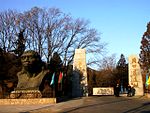
|
Beijing | 1987 | iii, vi | An archaeological site that has provided profound insights into prehistoric humanity. It is renowned for the discovery of Homo erectus pekinensis, commonly known as Peking Man, which represents significant evidence of early human life and evolution in East Asia. The site, excavated in the early 20th century, revealed a wealth of fossils and artifacts, including skulls, bones, and tools, dating back to approximately 770,000 to 230,000 years ago.449 |
| The Great Wall* | 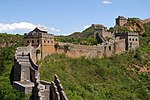
|
Northern China | 1987 | i, ii, iii, iv, vi | The Great Wall of China stretches over 13,000 miles across the country's northern frontier. Originally built in various sections by different states and dynasties to protect against invasions, the wall was most extensively fortified and linked during the Ming Dynasty (1368–1644). It traverses a diverse range of terrains, from deserts and mountains to rivers and plains, showcasing an ancient strategic military defense system.438 |
| Mount Huangshan *† | 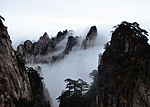
|
Huangshan City, Anhui | 1990 | ii, vii, x | Known as the Yellow Mountains, the mountain is famed for its unique geological formations, including peculiarly shaped granite peaks, hot springs, and ancient, gnarled pine trees that cling to the rocks in improbable locations. The scenic area encompasses notable peaks like the Lotus Peak, Bright Summit, and the Heavenly Capital Peak. Huangshan has been a source of inspiration for Chinese poets, painters, and philosophers for centuries, embodying the quintessential beauty of the Chinese wilderness.547 |
| Huanglong Scenic and Historic Interest Area † | 
|
Songpan County, Sichuan | 1992 | vii | Recognized for its colorful calcite pools, mountain landscapes, dense forests, and waterfalls and hosts a variety of ecosystems that are home to endangered species like the giant panda and the Sichuan golden snub-nosed monkey. Named "Yellow Dragon" for the yellow calcite deposits that shape its terraced pools, Huanglong's most notable feature is the Huanglong Valley. This area is characterized by its travertine pools, which vary in size and shape, and are known for their clear, colorful waters. Huanglong also contains ancient temples and shrines.638 |
| Jiuzhaigou Valley Scenic and Historic Interest Area † | 
|
Jiuzhaigou County, Sichuan | 1992 | vii | A national park characterized by its rich biodiversity, including several endangered species and a range of flora and fauna endemic to the region. The valley's name, Jiuzhaigou, translates to "Nine Village Valley," referring to the nine Tibetan villages scattered throughout the park. Its water features, including the crystal-clear lakes and cascading waterfalls, are among its most distinctive attractions, notable for their vibrant colors which result from mineral deposits and algae present in the water.637 |
| Wulingyuan Scenic and Historic Interest Area † | 
|
Zhangjiajie, Hunan | 1992 | vii | The area encompasses several national parks, the most famous of which is Zhangjiajie National Forest Park. This area is notable for its more than 3,000 quartzite sandstone pillars and peaks. The region also features ravines, gorges, waterfalls, streams, and natural bridges, as well as caves and two large natural reserves. In addition you will find various species of plants and wildlife, some of which are rare or endangered. 640 |
| Historic Ensemble of the Potala Palace, including the Jokhang Temple and Norbulingka * | 
|
Lhasa, Tibet | 1994, 2000, 2001 | i, iv, vi | The Historic Ensemble of the Potala Palace, including the Jokhang Temple and Norbulingka, encompasses a group of significant sites central to Tibetan Buddhism and the governance of Tibet.
The Potala Palace, once the winter residence of the Dalai Lamas, stands as a monumental structure on Marpo Ri hill, showcasing Tibetan architectural and artistic traditions. It contains thousands of rooms, chapels, and libraries, filled with invaluable art and manuscripts. The Jokhang Temple, considered the spiritual heart of Tibet, is a crucial pilgrimage site, housing the revered statue of Jowo Rinpoche. It embodies the essence of Tibetan Buddhism in its architecture and the devotion it inspires. Norbulingka, the summer palace of the Dalai Lamas, is set within a large park and garden complex, illustrating the integration of Tibetan and Han architectural styles. It served as a cultural and religious center, playing a vital role in the spiritual and administrative life of Tibet.707 |
| Ancient Building Complex in the Wudang Mountains * | 
|
Hubei | 1994 | i, ii, vi | The Ancient Building Complex in the Wudang Mountains consists of a collection of Taoist temples and monasteries developed during the Ming Dynasty. The complex is set within the natural landscape of the Wudang Mountains, reflecting Taoist principles of harmony between humans and nature.
The site includes structures such as the Nanyan Temple and the Purple Cloud Palace, which are integrated with the mountainous terrain. These buildings are important for Taoist practices, including rituals, martial arts, and meditation.705 |
| Chengde Mountain Resort and its Outlying Temples in Chengde * | 
|
Chengde, Hebei | 1994 | ii, iv | Built during the Qing Dynasty as a summer retreat for the emperors, the resort is spread over a vast area, showcasing a blend of Chinese landscaping art with natural landscapes, including lakes, gardens, palaces, and pavilions. The outlying temples, constructed in various architectural styles mimicking those from different regions of China, were intended to promote unity among the diverse ethnic groups within the Qing Empire. These temples, combining Han, Tibetan, and Mongolian architectural elements, stand as a testament to the religious and cultural inclusiveness of the Qing Dynasty.703 |
| Temple and Cemetery of Confucius and the Kong Family Mansion in Qufu * | 
|
Qufu, Shandong | 1994 | i, iv, vi | The temple, originally built in 478 BC and expanded over centuries, serves as one of the largest and most important sites honoring Confucius. It showcases traditional Chinese architectural styles and houses numerous steles and artifacts related to Confucius and his teachings. Adjacent to the temple, the Kong Family Mansion was the historical residence of the direct descendants of Confucius. The Cemetery of Confucius, also part of the complex, is where Confucius and many of his descendants are buried, encompassing a large wooded area with tombstones and memorial tablets.704 |
| Mount Emei Scenic Area, including Leshan Giant Buddha Scenic Area *† | 
|
Emeishan City (Mt. Emei) and Leshan (Giant Buddha), Sichuan | 1996 | iv, vi, x | Mount Emei is one of the four sacred Buddhist mountains in China, celebrated for its natural beauty, rich biodiversity, and ancient temples. The mountain is home to the first Buddhist temple in China, built in the 1st century CE, and has since been a site of pilgrimage.
The Leshan Giant Buddha is a monumental 71-meter tall stone statue carved out of a cliff face during the 8th century, representing Maitreya Buddha. It is one of the largest and tallest stone Buddha statues in the world, notable for its intricate construction that included an internal drainage system to protect it from erosion.779 |
| Mountain Lu National Park * | 
|
Jiujiang, Jiangxi | 1996 | ii, iii, iv, vi | The park is known for its granite peaks, dense vegetation, waterfalls, and cloud-covered landscapes and has served as a retreat for scholars, artists, and political figures throughout Chinese history, influencing poetry, painting, and philosophy. The area includes historical buildings, temples, and villas that reflect its cultural and educational significance. Mountain Lu National Park represents a blend of natural landscapes and cultural history.778 |
| Ancient City of Pingyao * | 
|
Pingyao County, Shanxi | 1997 | ii, iii, iv | A traditional Han Chinese city from the Ming and Qing dynasties. The city is notable for its ancient city walls, which remain largely intact and encircle the old town, and for being the site of one of the first banks in China.812 |
| Classical Gardens of Suzhou * | 
|
Suzhou, Jiangsu | 1997, 2000 | i, ii, iii, iv, v | A group of private gardens that were developed from the 11th to 19th centuries. Each garden in Suzhou showcases the classic elements of Chinese garden art, including water features, rockeries, pavilions, bridges, and meticulously arranged plants, designed to create harmonious and miniature landscapes that reflect the natural world. The gardens were intended as spaces for contemplation and retreat from the outside world, embodying ideals of harmony and tranquility. Among the most famous of these gardens are the Humble Administrator's Garden and the Lingering Garden.813 |
| Old Town of Lijiang * | 
|
Lijiang, Yunnan | 1997 | ii, iv, v | A preserved ancient town that reflects the cultural heritage of the Naxi people, an ethnic minority with a unique blend of cultural influences. Established in the late Song Dynasty and early Yuan Dynasty, it is known for its distinctive historical architecture, including traditional timber-framed houses with tiled roofs and a complex system of waterways and bridges. Lijiang's layout is influenced by the local geography and traditional feng shui principles, resulting in a harmonious integration of the town with its natural surroundings. The town also serves as a hub for Naxi culture, evident in its music, art, and festivals.811 |
| Summer Palace * | 
|
Beijing | 1998 | i, ii, iii | An ensemble of lakes, gardens, and palaces. It was established in the Qing Dynasty as a royal retreat for emperors seeking respite from the Forbidden City and to escape the summer heat. The design of the Summer Palace embodies the philosophy of harmonizing human architecture with the natural landscape, drawing inspiration from various gardens across China to create a comprehensive representation of Chinese garden art. The palace complex is centered around Kunming Lake and Longevity Hill, featuring a variety of structures such as pavilions, halls, palaces, temples, and bridges, set amidst meticulously landscaped gardens.880 |
| Temple of Heaven * | 
|
Beijing | 1998 | i, ii, iii | A complex of religious buildings where emperors of the Ming and Qing Dynasties conducted annual ceremonies of prayer to Heaven for a good harvest. The architecture and layout of the Temple of Heaven are characterized by their symbolic representation of heaven and earth, with the Circular Mound Altar, the Imperial Vault of Heaven, and the Hall of Prayer for Good Harvests as its core components. These structures are noted for their precise geometrical forms and harmonious proportions, designed according to cosmological principles to reflect the celestial world.881 |
| Dazu Rock Carvings * | 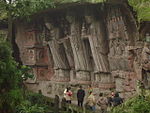
|
Dazu District, Chongqing | 1999 | i, ii, iii | A series of Chinese religious sculptures and carvings dating back to the 7th. These carvings are spread out over 75 protected sites and depict and are influenced by Buddhist, Confucian, and Taoist beliefs. The carvings are noted for their aesthetic quality, rich diversity of subject matter, both secular and religious, and the light they shed on everyday life in China during this period.
Among the most famous of these carvings is the statue of the Thousand-Handed Avalokitesvara, and the Dazu Rock Carvings.912 |
| Mount Wuyi *† | 
|
Fujian, Jiangxi | 1999 | ii, vi, vii, x | Historically, Mount Wuyi was a center for the development of Neo-Confucianism, a significant cultural movement in the 11th century that blended Confucianism with other philosophical traditions. The area is also renowned for its association with the production of Da Hong Pao tea, one of the most famous oolong teas in China and is recognized for its biodiversity, including numerous rare and endemic species of plants and animals.911 |
| Ancient Villages in Southern Anhui – Xidi and Hongcun * | 
|
Yi County, Anhui | 2000 | iii, iv, v | Two traditional villages dating back to the Ming and Qing Dynasties. Notable for their distinctive architecture and the layout that reflects the traditional Chinese feng shui and rural life. Xidi and Hongcun are characterized by their narrow lanes, ornate Huizhou-style houses with white walls and dark tiled roofs, and elaborate carvings that decorate windows, doors, and beams. Both villages are set against a backdrop of picturesque landscapes, with Hongcun famous for its water system designed to resemble the shape of an ox, demonstrating an ingenious integration of the community with its environment.1002 |
| Imperial Tombs of the Ming and Qing Dynasties, including the Ming tombs and the Ming Xiaoling Mausoleum * |   
|
Beijing and Nanjing, Jiangsu | 2000, 2003, 2004 | i, ii, iii, iv, vi | The Ming tombs, are a collection of imperial mausoleums where 13 emperors of the Ming Dynasty (1368–1644) are buried. The Ming Xiaoling Mausoleum, is the burial site of the first Ming emperor, Zhu Yuanzhang, and his empress. This site is characterized by its path lined with stone statues, which leads to the main burial mound. The design and layout of the tombs are planned to symbolize the unity and dignity of the emperor's rule, incorporating architectural elements and geomantic principles to ensure peace and harmony in the afterlife.1004 |
| Longmen Grottoes * | 
|
Luoyang, Henan | 2000 | i, ii, iii | A collection of Buddhist cave temples carved into the limestone cliffs of the Xiangshan and Longmenshan mountains. Dating from the late Northern Wei to the Tang Dynasty (5th to 10th centuries), these grottoes contain tens of thousands of statues of Buddha and his disciples, ranging in size from a few centimeters to several meters tall. The site is renowned for its impressive array of Buddhist art, which includes intricately carved statues, inscriptions, and reliefs. The Longmen Grottoes reflect the high point of Chinese stone carving, and the Fengxian Temple, with its colossal statue of Vairocana Buddha, is among the most celebrated of these carvings.1003 |
| Mount Qingcheng and the Dujiangyan Irrigation System * | 
|
Dujiangyan City, Sichuan | 2000 | ii, iv, vi | Mount Qingcheng is one of the birthplaces of Taoism, China's indigenous religion, and is dotted with ancient Taoist temples amid its lush forested landscape, offering a serene and spiritual experience.
The Dujiangyan Irrigation System, constructed in the 3rd century BCE, is an ancient technological marvel still in use today. It was ingeniously designed to control flooding and irrigate farmland along the Minjiang River by dividing the river into channels. This system transformed the Sichuan basin into one of China's most fertile regions without the need for a dam, showcasing early Chinese engineering skills.1001 |
| Yungang Grottoes * | 
|
Datong, Shanxi | 2001 | i, ii, iii, iv | A series of ancient Buddhist temple grottoes dating back to the 5th and 6th centuries. These grottoes are carved into the side of a sandstone cliff and contain thousands of statues and intricate murals that represent some of the outstanding examples of early Chinese Buddhist art. Comprising 252 caves and over 51,000 Buddha statues, the Yungang Grottoes showcase a variety of artistic styles and influences, reflecting the cultural exchange between China and other regions along the Silk Road. The site is notable for its large-scale statues, which exhibit a blend of Indian and Chinese art styles.1039 |
| Three Parallel Rivers of Yunnan Protected Areas † | 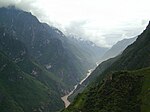
|
Yunnan | 2003 | vii, viii, ix, x | Where the Yangtze, Mekong, and Salween rivers run roughly parallel to each other through deep gorges and mountainous terrain. This area is noted for its exceptional biodiversity and significant topographical diversity, ranging from snow-capped peaks to tropical rainforests, hosting a wide array of flora and fauna, including many endemic and endangered species.1083 |
| Capital Cities and Tombs of the Ancient Koguryo Kingdom * | 
|
Ji'an, Jilin | 2004 | i, ii, iii, iv, v | The site represent the archaeological remnants of the Koguryo Kingdom, one of the Three Kingdoms of Korea, which existed from the 1st century BC to the 7th century AD. The Site encompasses two main components: the capital cities of Wunu Mountain City, Guonei City, and Wandu Mountain City, along with a series of royal tombs found in the region. The capital cities illustrate the urban planning and defensive architectures typical of the Koguryo Kingdom, showcasing the sophistication and strategic ingenuity of Koguryo urban design and military fortifications. The tombs are famous for their wall paintings, which depict daily life scenes, mythical figures, and the spiritual beliefs of the Koguryo people.1135 |
| Historic Centre of Macau * | 
|
Macau | 2005 | ii, iii, iv, vi | A collection of over twenty locations that testify to the successful fusion of Chinese and Portuguese cultures in Macau. The Historic Centre includes a range of buildings and public spaces that illustrate the integration of architectural, technological, and artistic influences from both East and West. Notable landmarks within the Historic Centre include the Ruins of St. Paul's, the Senado Square, A-Ma Temple, and the Guia Fortres. |
| Yinxu * | 
|
Anyang, Henan | 2006 | ii, iii, iv, vi | The archaeological site of the ancient capital of the late Shang Dynasty, dating from the 14th to the 11th centuries BCE. Yinxu is known for its collection of artifacts, including oracle bones, bronze ware, and royal tombs. The site also includes the remains of large palatial structures and royal tombs.1114 |
| Sichuan Giant Panda Sanctuaries † | 
|
Sichuan | 2006 | x | Approximately 9,000 square kilometers of forested and mountainous terrain. Home to more than 30% of the world's endangered giant pandas.
The sanctuaries include several national parks and reserves such as Wolong, Mt. Siguniang, and Jiajin Mountains. These areas provide a refugefor the giant pandaand other endangered species such as the red panda, the snow leopard, and the clouded leopard. 1213 |
| Kaiping Diaolou and Villages * | 
|
Kaiping, Guangdong | 2007 | ii, iii, iv | The site consists of several fortified multi-story towers, known as "diaolou," and traditional villages. The diaolou served both as residential houses and as protective fortresses against banditry and local wars. They are characterized by their Roman, Baroque, and even Gothic elements alongside traditional Chinese designs. 1112 |
| South China Karst † | 
|
Yunnan, Guizhou, Chongqing and Guangxi | 2007, 2014 | vii, viii | The area is divided into three: the Libo Karst, Shilin Karst, and Wulong Karst. Each of these areas showcases different karst formations that have evolved over millions of years. For instance, the Shilin Karst is known for its stone forests, while the Wulong Karst features natural bridges and giant dolines (sinkholes).1248 |
| Fujian Tulou * | 
|
Fujian | 2008 | iii, iv, v | Constructed between the 12th and 20th centuries, these buildings are recognized for their circular or rectangular shapes. Designed to house up to 800 people, each Tulou functions as a self-contained community, featuring thick earth walls that provide security and moderate internal temperatures. The architectural layout includes a central courtyard surrounded by multi-story living quarters.1113 |
| Sanqingshan † | 
|
Yushan County, Jiangxi | 2008 | vii | Characterized by its pillars and peaks. The area spans 2,300 hectares and is known for its three main peaks, which are said to represent the three supreme gods in Taoism. Sanqingshan is home to many ancient temples, some of which are hidden in its many caves and crevices.1292 |
| Mount Wutai * | 
|
Wutai County, Shanxi | 2009 | ii, iii, iv, vi | The mountain is recognized as one of the Four Sacred Buddhist Mountains of China. The name "Wutai" means "Five Terraces," reflecting the mountain's five flat peaks, which are said to symbolize the five elements of earth, water, fire, wind, and void.
Mount Wutai is home to temples, 53 monasteries, and numerous other religious structures.1279 |
| Historic Monuments of Dengfeng in "The Centre of Heaven and Earth" * | 
|
Dengfeng, Henan | 2010 | iii, vi | Known as "The Centre of Heaven and Earth". The ensemble includes various temples, pagodas, and academies dating back as far as the Han Dynasty. Among these, the Shaolin Temple, often credited as the birthplace of Zen Buddhism and Shaolin martial arts. Other notable components include the Songyue Pagoda, one of the oldest brick pagodas in China, and the Observatory of Dengfeng.1305 |
| China Danxia † | 
|
Hunan, Guangdong, Fujian, Jiangxi, Zhejiang, and Guizhou | 2010 | vii, viii | China Danxia is a type of karst landform characterized by red sandstone cliffs and a range of erosional landscapes, including natural pillars, towers, ravines, valleys, and waterfalls. Danxia formations are spread across several regions in southeastern and southwestern China, including areas in Guangdong, Fujian, Jiangxi, Hunan, and Zhejiang provinces.1335 |
| West Lake Cultural Landscape of Hangzhou * | 
|
Hangzhou, Zhejiang | 2011 | ii, iii, vi | characterized by its lake, surrounding hills, gardens, and historic sites. Located in the city of Hangzhou, Zhejiang Province, West Lake is surrounded by numerous temples, pagodas, pavilions, and gardens.1334 |
| Site of Xanadu * | 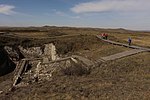
|
Zhenglan Banner, Xilingol League, Inner Mongolia | 2012 | ii, iii, iv, vi | An archaeological site that was once the summer capital of Kublai Khan's Yuan Dynasty. This site encompasses the ruins of the imperial city of Xanadu. The remains include palace foundations, city walls, and other structures that offer insight into the layout and architecture of the ancient city.
Xanadu is notable for its strategic location along the Silk Road and its role as a political and cultural center during the Yuan Dynasty. It served as a symbol of imperial power and a hub for trade and cultural exchange between East and West. 1389 |
| Chengjiang Fossil Site † | 
|
Chengjiang County, Yunnan | 2012 | viii | Archaeological site renowned for its preserved fossils dating back to the Cambrian period. The fossils found here include a wide variety of preserved organisms, such as trilobites, sponges, algae, and the iconic Chengjiang Biota, which comprises numerous soft-bodied organisms rarely preserved in the fossil record.1388 |
| Xinjiang Tianshan † | 
|
Xinjiang | 2013 | vii, ix | 1414 |
| Cultural Landscape of Honghe Hani Rice Terraces * | 
|
Yuanyang County, Yunnan | 2013 | iii, v | 1111 |
| Silk Roads: the Routes Network of Chang'an-Tianshan Corridor * | 
|
Luoyang, Lingbao of Henan; Xi'an, Bin County and Chenggu of Shaanxi; Tianshui, Yongjing, Dunhuang and Anxi of Gansu; Turpan, Jimsar and Kuqa of Xinjiang | 2014 | ii, iii, v, vi | 1442 |
| Grand Canal * | 
|
Beijing, Tianjin, Hebei, Shandong, Jiangsu, Zhejiang, Anhui and Henan | 2014 | i, iii, iv, vi | 1443 |
| Tusi Sites * | 
|
Hunan, Hubei and Guizhou | 2015 | ii, iii | 1474 |
| Zuojiang Huashan Rock Art Cultural Landscape * | 
|
Guangxi | 2016 | iii, vi | 1508 |
| Hubei Shennongjia † | 
|
Hubei | 2016 | ix, x | 1509 |
| Qinghai Hoh Xil † | 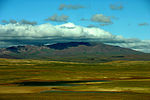
|
Qinghai | 2017 | vii, x | 1540 |
| Kulangsu: a Historic International Settlement * | 
|
Xiamen, Fujian | 2017 | ii, vi | 1541 |
| Fanjingshan † | 
|
Tongren, Guizhou | 2018 | x | 1559 |
| Archaeological Ruins of Liangzhu City * | 
|
Hangzhou and Deqing County, Zhejiang | 2019 | iii, iv | 1592 |
| Migratory Bird Sanctuaries along the Coast of Yellow Sea-Bohai Gulf of China (Phase I) † | Yancheng, Jiangsu | 2019 | x | 1606 | |
| Quanzhou: Emporium of the World in Song-Yuan China * | 
|
Quanzhou, Fujian | 2021 | iv | 1561 |
| Cultural Landscape of Old Tea Forests of the Jingmai Mountain in Pu’er * | 
|
Yunnan | 2023 | iii, v | 1665 |
Tentative list
[edit]There are the sites China has submitted to the UNESCO World Heritage tentative list.[2]
- Dongzhai Port Nature Reserve (1996)
- The Alligator Sinensis Nature Reserve (1996)
- Poyang Nature Reserve (1996)
- The Lijiang River Scenic Zone at Guilin (1996)
- Yalong, Tibet (2001)
- Yangtze Gorges Scenic Spot (2001)
- Jinfushan Scenic Spot (2001)
- Heaven Pit and Ground Seam Scenic Spot (2001)
- Hua Shan Scenic Area (2001)
- Yandang Mountains (2001)
- Nanxi River (2001)
- Maijishan Scenic Spots (2001)
- Wudalianchi Scenic Spots (2001)
- Haitan Scenic Spots (2001)
- Dali Cangshan Mountain and Erhai Lake Scenic Spot (2001)
- Sites for Liquor Making in China (2008)
- Ancient Residences in Shanxi and Shaanxi Provinces (2008)
- City Walls of the Ming and Qing Dynasties (2008)
- Slender West Lake and Historic Urban Area in Yangzhou (2008)
- Ancient Water Towns South of the Yangtze River (Zhouzhuang, Luzhi, Wuzhen, and Xitang) (2008)
- Fenghuang Ancient City (2008)
- Sites of the Southern Yue State (2008)
- Baiheliang Ancient Hydrological Inscription (2008)
- Miao Nationality Villages in Southeast Guizhou Province: The villages of Miao Nationality at the Foot of Leigong Mountain in Miao Ling Mountains (2008)
- Karez Wells (2008)
- Expansion Project of Imperial Tombs of the Ming and Qing Dynasties: King Lujian’s Tombs (2008)
- The Four Sacred Mountains as an extension of Mt. Taishan (2008)
- Taklimakan Desert–Populus euphratica Forests (2010)
- China Altay (2010)
- Karakorum–Pamir (2010)
- The Central Axis of Beijing (including Beihai) (2013)
- Wooden Structures of Liao Dynasty – Wooden Pagoda of Yingxian County, Main Hall of Fengguo Monastery of Yixian County (2013)
- Sites of the Hongshan Culture: Niuheliang, Hongshanhou, and Weijiawopu (2013)
- Ancient Porcelain Kiln Site in China (2013)
- Sanfang Qixiang (2013)
- Western Xia Imperial Tombs (2013)
- Dong Villages (2013)
- Lingqu Canal (2013)
- Diaolou Buildings and Villages for Tibetan and Qiang Ethnic Groups (2013)
- Archaeological Sites of the Ancient Shu State: Jinsha site and Joint Tombs of Boat-shaped Coffins in Chengdu, Sichuan; Sanxingdui site in Guanghan, 29th – 5th century BC (2013)
- Xinjiang Yardang (2015)
- Dunhuang Yardangs (2015)
- Tianzhushan (2015)
- Jinggangshan–North Wuyishan (extension of Mount Wuyi) (2015)
- Shudao (2015)
- Tulin–Guge Scenic and Historic Interest Areas (2015)
- The Chinese Section of the Silk Roads (2016)
- Guancen Mountain – Luya Mountain (2017)
- Hulun Buir Landscape and Birthplace of Ancient Minority (2017)
- Qinghai Lake (2017)
- Scenic and historic area of Sacred Mountains and Lakes (Gang Rinpoche, Naimona'nyi, Lake Manasarovar and Lhanag-tso) (2017)
- Taihang Mountain (2017)
- Vertical Vegetation Landscape and Volcanic Landscape in Changbai Mountain (2017)
- Badain Jaran Desert—Towers of Sand and Lakes (2019)
- Guizhou Triassic Fossil Sites (2019)
- Huangguoshu Scenic Area (2019)
- Hainan Tropical Rainforest and the Traditional Settlement of Li Ethnic Group (2022)
- Fujian Minjiang River Estuary: The ecotone between marine and terrestrial biogeographical regions (2022)
- Hezheng Mammalian Fossil Sites of Gansu (2024)
See also
[edit]- List of UNESCO Biosphere Reserves in China
- Major Historical and Cultural Sites Protected at the National Level
- Cultural heritage of China
- Principles for the Conservation of Heritage Sites in China
- List of World Heritage Sites in Asia (see template below for more regions)
- Table of World Heritage Sites by country
- UNESCO World Heritage Site
- World Heritage Committee
References
[edit]- ^ "China". whc.unesco.org. Retrieved 28 September 2021.
- ^ Centre, UNESCO World Heritage. "UNESCO World Heritage Centre – Tentative Lists". whc.unesco.org. Retrieved 9 April 2019.
External links
[edit]World Heritage Sites in China.
| East |
| |
|---|---|---|
| South Central |
| |
| Southwestern | ||
| North | ||
| Northeast | ||
| Northwestern | ||
| Multiple regions | ||
| Northern and Central Asia | ||
|---|---|---|
| Western Asia (including Arab States) | ||
| Eastern Asia | ||
| Southern Asia | ||
| Southeast Asia | ||
| Locations | ||
|---|---|---|
| Related | ||



